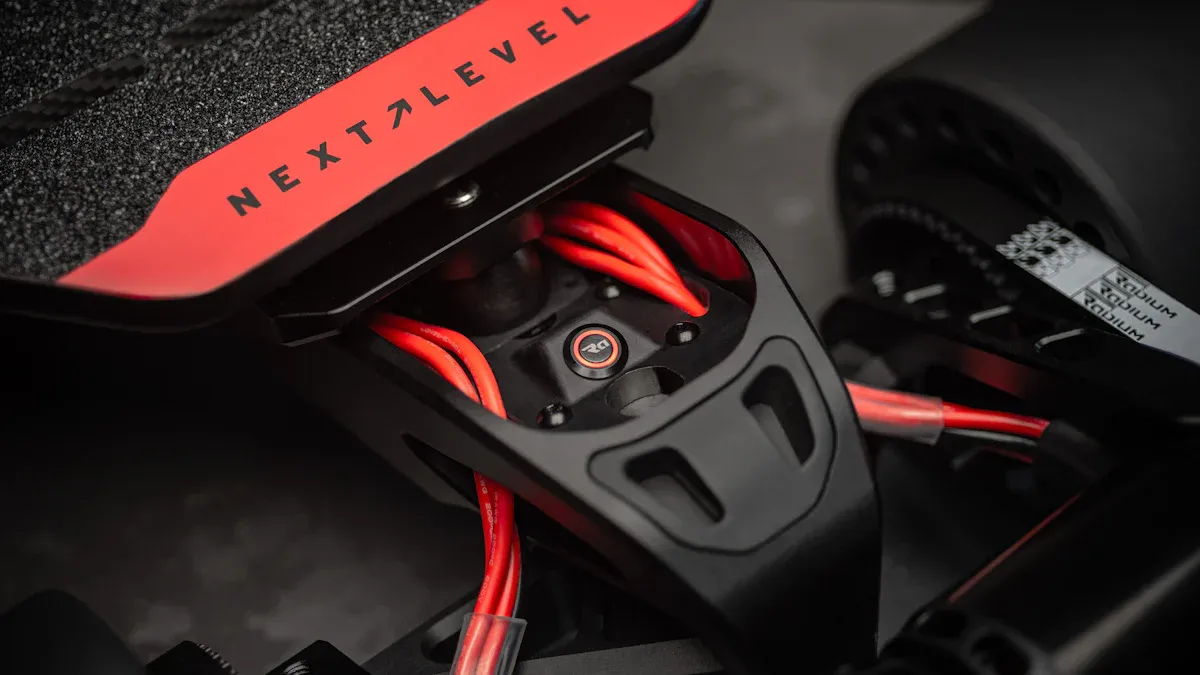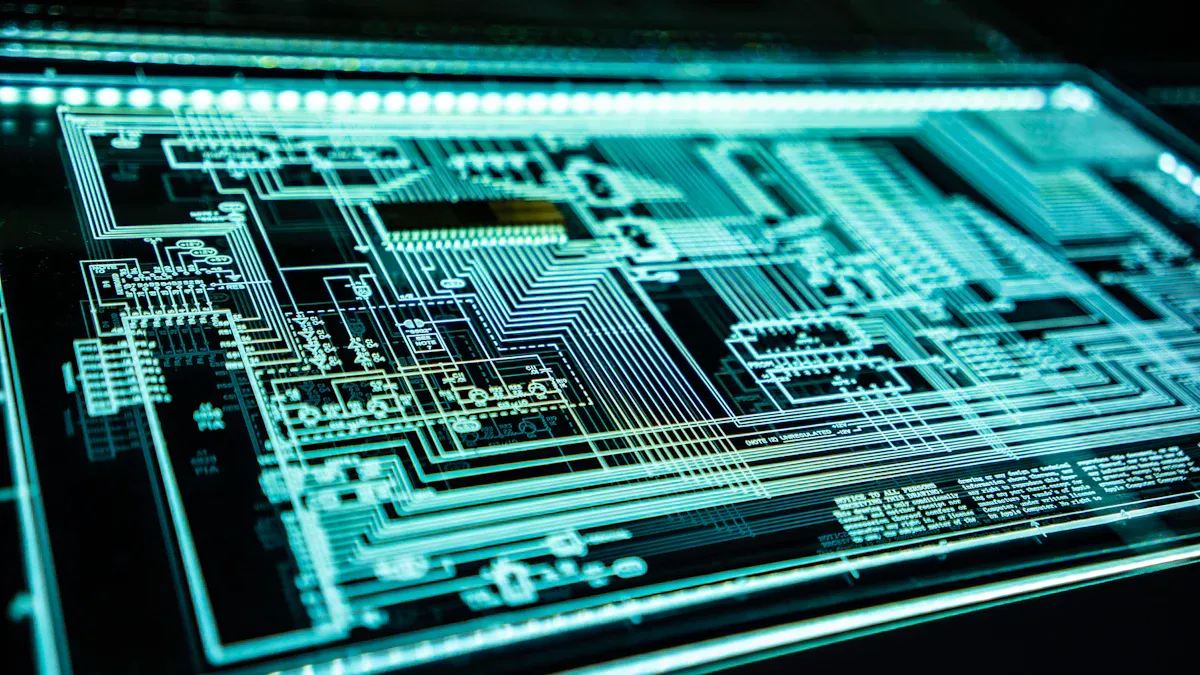You want your automotive systems to run at peak performance. Flexible circuit board technology gives you the edge with flexible adaptability, flexible space savings, and flexible reliability under tough conditions. You replace rigid boards with flexible solutions because you demand systems that bend, twist, and fit into compact spaces. Flexible designs help you achieve lighter vehicles, streamlined wiring, and enhanced durability. Choose flexible innovation to drive your automotive goals forward.
Key Takeaways
- Flexible circuit boards fit into tight spaces, allowing for lighter and more efficient vehicle designs.
- These boards enhance reliability by reducing failure points, leading to fewer breakdowns and lower maintenance costs.
- Flexible technology supports advanced safety features, ensuring quick response times and improved protection for drivers and passengers.
- Using flexible circuit boards boosts fuel efficiency by reducing weight and optimizing space for advanced electronics.
- Investing in flexible solutions empowers automotive innovation, enabling smarter designs and better performance.
Flexible Circuit Board Fundamentals
Structure and Materials
You want your automotive systems to deliver top performance. The structure of a flexible circuit board gives you a clear advantage. Flexible printed circuit boards use thin, bendable layers that fit into tight spaces and unusual shapes. This flexible design lets you route connections around corners and through compact areas, making your vehicle lighter and more efficient.
The materials in flexible circuit boards set them apart in the automotive industry. You benefit from advanced technology that uses strong, flexible materials. See how these materials contribute to performance:
| Material Type | Contribution to Performance |
|---|---|
| Polyimide | Provides flexibility and durability in harsh conditions. |
| Liquid Crystal Polymer | Enhances integration of advanced electronics in compact spaces. |
Polyimide stands up to heat and vibration, so your electronics stay reliable. Liquid crystal polymer lets you pack more technology into smaller areas, boosting your vehicle’s capabilities. You get flexible solutions that work in the most demanding automotive environments.
Unique Properties for Vehicles
Flexible circuit boards offer unique properties that make them essential for automotive applications. You gain flexible technology that resists vibration and temperature swings. Flexible printed circuit boards maintain performance even when your vehicle faces rough roads or extreme weather.
- Protecting your circuit boards after manufacturing ensures long-term reliability.
- Storing boards on sturdy shelves in climate-controlled spaces prevents damage from temperature changes.
- Teardrops in PCB design help your systems stay operational during vibration and thermal stress.
You choose flexible solutions because they adapt to the challenges of the automotive industry. Flexible circuit boards give you the confidence to push your vehicle’s technology further. You achieve better performance, greater reliability, and smarter designs with flexible innovation.
Key Benefits in Automotive Systems
Reliability and Durability
You demand reliability from every component in your automotive systems. Flexible circuit board technology delivers this advantage by reducing the number of connectors and solder joints, which are the most common failure points in traditional designs. When you use flexible solutions, you minimize the risk of electrical failures and improve the long-term durability of your vehicles. This approach means fewer breakdowns and less maintenance, so you can trust your electronics to perform under harsh conditions. In the automotive industry, you need systems that withstand vibration, heat, and constant movement. Flexible circuit boards give you that peace of mind, ensuring your control and safety systems work when you need them most.
When you choose flexible technology, you invest in higher reliability and better performance for every mile your vehicle travels.
Space and Weight Efficiency
You want to maximize every inch inside your vehicles. Flexible circuit boards help you achieve this goal by offering significant space and weight savings. Here’s how flexible solutions transform your automotive designs:
- Flexible circuit boards can weigh 75% to 90% less than traditional rigid PCBs.
- A typical 2-layer flexible circuit board has a thickness ranging from 4 to 10 mils (0.1-0.25 mm), much thinner than the 0.2-0.3 mm thickness of FR4 PCBs.
- By removing bulky connectors and cables, flexible PCBs make your vehicle designs more compact and lightweight.
These advantages allow you to create sleeker, more efficient vehicles. You reduce overall weight, which improves fuel efficiency and enhances vehicle performance. You also free up valuable space for other advanced electronics or comfort features. In the automotive industry, every gram and millimeter counts. Flexible technology gives you the edge to design smarter, lighter, and more competitive vehicles.
Design Flexibility
You want the freedom to innovate and push the boundaries of automotive design. Flexible circuit boards empower you to do just that. With their ability to bend and flex, these boards fit into tight spaces and adapt to the unique shapes of modern vehicles. You can route circuits around corners, integrate electronics into curved dashboards, and accommodate moving parts without sacrificing reliability or control.
- Flexible circuit boards bend and flex, fitting into compact spaces and handling dynamic movements—essential for complex automotive applications.
- They help reduce the weight and complexity of electric vehicle components, boosting energy efficiency and extending battery life.
- Flexible PCBs enable you to integrate advanced systems into dashboards and interiors without compromising design aesthetics.
When you use flexible technology, you unlock new possibilities for integrating electronics and control systems seamlessly into your vehicles. You can deliver better performance, smarter features, and a more attractive design—all while maintaining the highest standards of reliability. Flexible solutions let you lead the way in automotive innovation and set your vehicles apart from the competition.
Automotive Applications of Flexible Circuit Boards

Battery Management and Power
You want your automotive systems to deliver top performance every time. Flexible circuit boards give you a powerful advantage in battery management and power distribution. In electric vehicles, you need precise control over battery cells and efficient energy flow. Flexible solutions fit into tight battery compartments and handle complex routing. You reduce wiring bulk and improve heat dissipation. This technology helps you achieve better vehicle performance and longer battery life. Flexible designs also support advanced driver assistance systems by ensuring stable power delivery, even in demanding conditions.
Infotainment and Connectivity
You expect seamless entertainment and communication in your vehicles. Flexible circuit boards make this possible by enhancing connectivity and control systems. You can fit advanced electronics into curved dashboards and slim headliners. Flexible layouts allow you to create innovative applications of flexible pcbs, supporting touchscreens, audio systems, and wireless modules. The following table shows how flexible solutions boost performance in automotive infotainment and connectivity:
| Performance Metric | Description |
|---|---|
| Enhanced Reliability | Flexible circuit boards reduce the number of solder joints and connectors, minimizing potential errors. |
| Thermal Management | Their design allows for better heat dissipation, reducing the risk of hot spots that can damage components. |
| Flexibility and Adaptability | They can fit into irregular spaces and be routed through narrow channels, optimizing space usage. |
| Space and Weight Efficiency | They contribute to miniaturization by combining elements and reducing the need for multiple connectors. |
You gain reliable, high-quality infotainment that keeps drivers and passengers connected and entertained.
Sensors and Control
You rely on sensors and control systems to keep your vehicles safe and efficient. Flexible circuit boards support advanced driver assistance systems by connecting sensors throughout the vehicle. You can route flex circuits around corners and through moving parts. This flexibility ensures accurate data collection and fast response times. Flexible technology also improves reliability, so your control systems work flawlessly in every situation. You get better safety, smoother operation, and more responsive vehicles.
Instrument Panels and Interiors
You want your automotive interiors to look clean and modern. Flexible circuit boards let you design sleek instrument panels and smart interiors. You can integrate lighting, displays, and controls into curved surfaces. Flexible layouts enable 3D wiring, reducing clutter and making your designs stand out. In the automotive industry, this approach creates a premium feel and supports advanced features. You deliver comfort, style, and cutting-edge technology in every vehicle.
Flexible circuit boards transform the way you design and build automotive electronics. You achieve cleaner layouts, lighter vehicles, and superior control. Choose flexible solutions to lead the future of automotive innovation.
Flexible Circuit Boards in Safety Systems
Safety Features Integration
You want your vehicles to protect drivers and passengers at all times. Flexible circuit board integration gives you a clear advantage in automotive safety. You can embed advanced sensors, airbags, and emergency systems directly into tight spaces. This integration allows you to connect safety features seamlessly throughout the vehicle. You reduce wiring complexity and improve response times during critical moments.
- You can place crash sensors in optimal locations for faster airbag deployment.
- You can integrate seatbelt tensioners and lane departure warnings with fewer connection points.
- You achieve real-time data sharing between safety modules for better decision-making.
Flexible technology supports the integration of multiple safety systems without adding bulk. You gain the flexibility to design smarter, safer vehicles that meet the highest standards in the automotive industry.
Tip: Choose flexible circuit board integration to streamline your safety features and boost reliability.
Thermal and Wear Resistance
You need your safety systems to work in every condition. Flexible circuit boards deliver outstanding thermal and wear resistance. This technology stands up to the heat from engines and the friction from moving parts. You avoid failures caused by temperature spikes or constant vibration.
| Feature | Benefit for Safety Systems |
|---|---|
| High thermal stability | Maintains performance in hot environments |
| Wear resistance | Extends system reliability over time |
| Vibration tolerance | Prevents safety feature malfunctions |
You can trust flexible solutions to protect your automotive safety systems from harsh conditions. You ensure that every safety feature operates at peak performance, mile after mile. Flexible integration means you never compromise on reliability or protection.
Flexible vs. Traditional PCBs in Vehicles

Performance Comparison
You want your automotive systems to deliver the highest level of performance. Flexible circuit boards give you a clear advantage over traditional rigid PCBs. You can bend and shape flexible boards to fit into tight spaces inside vehicles. This flexibility lets you design smarter layouts and improve control over electronic functions. You get better vibration resistance, which means your systems stay reliable even on rough roads. Flexible boards handle heat and movement without losing performance. You can trust them to keep your control modules working in electric vehicles and other advanced automotive designs.
Tip: Choose flexible circuit boards to boost vehicle performance and achieve greater reliability in demanding environments.
Here is a quick comparison:
| Feature | Flexible PCBs | Traditional PCBs |
|---|---|---|
| Space Efficiency | High | Low |
| Vibration Resistance | Excellent | Moderate |
| Design Adaptability | Superior | Limited |
| Weight | Lightweight | Heavy |
| Control Integration | Seamless | Complex |
Cost and Value
You want to maximize value in every automotive project. Flexible circuit boards help you save money over time. You reduce the need for extra connectors and cables, which lowers assembly costs. You also cut down on maintenance because flexible boards last longer and resist wear. You spend less on repairs and replacements. Flexible solutions let you combine multiple functions into one board, which streamlines control systems and reduces overall costs.
- You save space and weight, which improves fuel efficiency and lowers energy use.
- You increase reliability, which means fewer breakdowns and less downtime.
- You gain more design freedom, which helps you create innovative vehicles that stand out.
Flexible circuit boards offer you a smart investment. You get better performance, lower costs, and more control over your automotive systems. Make the switch to flexible technology and see the difference in every vehicle you build.
You want your automotive systems to deliver top performance, reliability, and innovation. Flexible circuit boards give you these advantages by fitting into tight spaces, withstanding harsh conditions, and enhancing connectivity and control systems.
- You improve safety with advanced driver assistance and optimal power control.
- You boost efficiency and design flexibility in electric vehicles and modern interiors.
| Benefit | Impact on Automotive Systems |
|---|---|
| Enhanced design | Innovative, compact vehicle layouts |
| Improved reliability | Long-lasting, stable performance |
| Weight reduction | Better efficiency and control |
You drive the future by choosing flexible solutions for your next automotive project.










 2025-11-05
2025-11-05
 BEST
BEST


.png)
.png)
.png)
.png)

.png)

